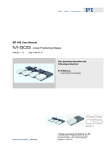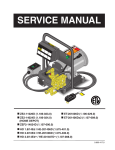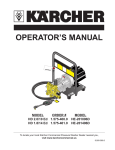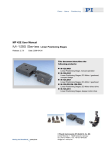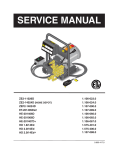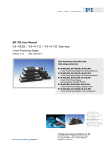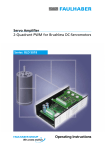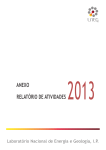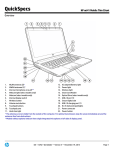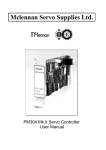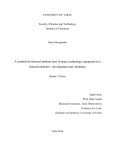Download 3 DC-Mike Drives and Motor Controllers
Transcript
MP 31E User Manual DC-Mike Drives, Stepper Mike Drives Release: 4.3.2 Date: 2005-09-09 This document describes the following product(s): M-222.xx DC-Mike Drives M-224.xx DC-Mike Drives M-226.xx DC-Mike Drives M-168.xx Stepper-Mike Drives © Physik Instrumente (PI) GmbH & Co. KG Auf der Römerstr. 1 ⋅ 76228 Karlsruhe, Germany Tel. +49-721-4846-0 ⋅ Fax: +49-721-4846-299 [email protected] ⋅ www.pi.ws Copyright 1999–2005 by Physik Instrumente (PI) GmbH & Co. KG, Karlsruhe, Germany. The texts, photographs and drawings in this manual enjoy copyright protection. With regard thereto, Physik Instrumente (PI) GmbH & Co. KG reserves all rights. Use of said texts, photographs and drawings is permitted only in parts and only upon citation of the source First printing 2005-09-09 Document Number MP 31E, Release 4.3.2 M-22x_User_MP31E432.doc This manual has been provided for information only and product specifications are subject to change without notice. Any change will be reflected in future printings. About this Document Users of this Manual This manual is designed to help the reader to install and operate the DC-Mike Drives, Stepper Mike Drives. It assumes that the reader has a fundamental understanding of basic servo systems, as well as motion control concepts and applicable safety procedures. The manual describes the physical specifications and dimensions of the DC-Mike Drives, Stepper Mike Drives as well as the hardware installation procedures which are required to put the associated motion system into operation. This document is available as PDF file on the product CD. Updated releases are available via FTP or email: contact your Physik Instrumente sales engineer or write [email protected] Conventions The notes and symbols used in this manual have the following meanings: WARNING Calls attention to a procedure, practice or condition which, if not correctly performed or adhered to, could result in injury or death. DANGER Indicates the presence of high voltage (> 50 V). Calls attention to a procedure, practice or condition which, if not correctly performed or adhered to, could result in injury or death. ! CAUTION Calls attention to a procedure, practice, or condition which, if not correctly performed or adhered to, could result in damage to equipment. NOTE Provides additional information or application hints. Related Documents The motion controller and the software tools, which might be delivered with DC-Mike Drives, Stepper Mike Drives, are described in their own manuals. All documents are available as PDF files on the Motion CD or special product CD. Updated releases are available via FTP or email: contact your Physik Instrumente sales engineer or write [email protected]. Contents 1 Model Survey 1.1 1.2 Safety Precautions .....................................................................3 DC-Mike Drives ..........................................................................3 1.2.1 1.3 1.4 2 Gearhead Ratios ........................................................................5 Cable Numbers ..........................................................................5 Using C-842 Motor Controllers...................................................8 Using C-844 Motor Controllers...................................................8 Direction of Motion .....................................................................9 4.2 Specifications: .......................................................................... 14 Pin Assignment (Dsub15f connector) : ................................... 15 Troubleshooting DC-Mikes 5.1 5.2 16 Blockage ..................................................................................16 5.1.1 5.1.2 Electrical Recovery .................................................................. 16 Mechanical Recovery............................................................... 16 Coupling Slippage ....................................................................17 M-168 Stepper Mikes 6.1 6.2 18 M-168.x0 5-Phase Linear Stepper Mikes .................................18 6.1.1 6.1.2 Pin Assignment : ...................................................................... 18 Specifications ........................................................................... 19 M-168.x2S Two-Phase Linear Stepper Mikes..........................20 6.2.1 www.pi.ws Connecting External Limit and Reference Switches:............... 11 Drive Units................................................................................13 4.2.1 4.2.2 6 11 M-224.50 / M-226.50 ................................................................11 4.1.1 5 8 DC-Mikes with 3-Watt Motors 4.1 6 Design Details ............................................................................6 Dimensions ................................................................................6 Mounting Recommendations......................................................7 Travel Ranges ............................................................................7 DC-Mike Drives and Motor Controllers 3.1 3.2 3.3 4 DC- and Stepper-Mike Summary ............................................... 4 Operating Considerations for DC-Mike Drives 2.1 2.2 2.3 2.4 3 3 Pin Assignment ........................................................................ 20 MP 31E Release 4.3.2 Page 1 Contents 6.2.2 6.3 6.4 Technical Data .........................................................................21 Dimensions ..............................................................................22 6.4.1 6.4.2 www.pi.ws Specifications ........................................................................... 20 M-168.10 / M-168.12S ............................................................. 22 M-168.30 / M-168.40 / M-168.22S / M-168.52S ...................... 22 MP 31E Release 4.3.2 Page 2 Model Survey 1 Model Survey PI offers motorized micrometers as DC-motor-driven units (DCMikes) or as stepper-motor-driven units (Stepper-Mikes). Both are high-precision linear drives offering repeatabilities of up to 0.1 µm. They can be mounted on mechanical stages like normal hand-driven micrometers. The more sophisticated M-230 DC-Mike series, with limit switches, reference switch, and, for the M-235, a heavy-duty ballscrew drive, is described in a separate manual. 1.1 Safety Precautions Following safety precautions should be observed before operating DC-Mike Drives: WARNING DC-Mikes and Stepper-Mikes are motorized and can generate high forces. If handled improperly, the drives may cause injuries. Be aware that failure of the motor controller may drive the DC-Mike or Stepper-Mike into a hard stop generating a large force. To avoid injury, do not put any parts in the gap between the moving DC-Mike/Stepper-Mike and any rigid structure. Never put your finger at a place where the moving DCMike/Stepper-Mike or any connected object could possibly trap it! CAUTION When the DC-Mike is connected to a DC-Motor Controller (and / or amplifier) be aware that the drive could start an undesired move due to whatever reason. 1.2 DC-Mike Drives The PI DC-Mike Drives described in this manual are motorized micrometers consisting of a micrometer with non-rotating spindle (pitch: 0.5 mm/rev), a DC-Motor gearhead combination and an optional encoder (for use with DC-Motor ServoController). Vacuum versions of the DC-Mikes are also www.pi.ws MP 31E Release 4.3.2 Page 3 ! Model Survey available, and will be included in the next release of this manual. General Specifications Purpose: High-Resolution DC-Mike Actuators Tip: Non-rotating Pitch: 0.5 mm/rev. Motor: DC Motor (2 or 3 Watts), Stepper Motor Operating voltage: 12 V 1.2.1 DC- and Stepper-Mike Summary Model Travel [mm] Motor Type Motor Model Gear Head Ratio Encoder Res. [c/rev.] M-222.20 10 mm DC, 2W C-120.80 141:1 60 M-222.50 10 mm DC, 3W C-136.10 29.6:1 2000 M-224.20 25 mm DC, 2W C-120.80 141:1 60 M-224.50 25 mm DC, 3W C-136.10 29.6:1 2000 M-226.20 50 mm DC, 2W C-120.80 141:1 60 M-226.50 50 mm DC, 3W C-136.10 29.6:1 2000 M-168.10 10 mm 5-phase SM C-545.00 none no encoder M-168.30 25 mm 5-phase SM C-545.00 none no encoder M-168.40 50 mm 5-phase SM C-545.00 none no encoder M-168.12S 10 mm 2-phase SM 4H4009L03-B none no encoder M-168.22S 25 mm 2-phase SM 4H4009L03-B none no encoder M-168.52S 50 mm 2-phase SM 4H4009L03-B none no encoder DC: DC-Motor, SM: Stepper Motor M-227 to M-235 are described in other manuals. www.pi.ws MP 31E Release 4.3.2 Page 4 Model Survey 1.3 Gearhead Ratios Gear- Exact Ratio head 1.4 Translation Factor Design Resolution 141:1 (31/9) 4 = 16,89110196616 0,05920276853477 140.7591830514 :1 c/µm µm/c 29.6:1 (28/12) 4 = 29.641975308 :1 118,5679012346 0,008433985839234 c/µm µm/c Cable Numbers www.pi.ws For M-222.20, M-224.20, M-226.20 use: C-815.62 Cable For M-222.50, M-224.50, M-226.50 use: C-815.38 Cable MP 31E Release 4.3.2 Page 5 Operating Considerations for DC-Mike Drives 2 Operating Considerations for DC-Mike Drives 2.1 Design Details A flexible coupling with high torsional stiffness transmits the motor output torque to the micrometer screw. This coupling does not allow any slip in the transmission. If the micrometer gets locked while the full operating voltage is applied to the motor, the gearhead, the screw or externally connected parts may be damaged. 2.2 Dimensions Dimensions in mm, decimal places separated by commas in drawings Fig. 1: M-22x.20 Drawing reference: M-221.20 see M-222.20 M-223.20 see M-224.20 M-225.20 see M-226.20 www.pi.ws MP 31E Release 4.3.2 Page 6 Operating Considerations for DC-Mike Drives 2.3 Mounting Recommendations Whenever possible the DC-Mike drives should be mounted with two holders, at least one of them clamping at the 19 mm diameter (the silverish front part). Clamping force at the 16mm diameter shaft should be as small as possible to avoid high friction and possible damage to the screw. Can also be clamped here. To avoid excessive friction, clamp here but do not overtighten: note this is a “weak” shaft. Fig. 2: Mounting DC-Mike drives 2.4 Travel Ranges DC-Mike Drives are available with travel ranges of 10, 25 and 50 mm. Since the compact design does not allow for internal limit switches care has to be taken not to exceed the allowed range. CAUTION To avoid damage, do not drive DC-Mike Drives to the mechanical limits. If driven beyond its limits, the non-rotating screw may bind and be damaged. The drives will have to be disassembled to loosen the screw. As all PI motor controllers support limit switches, we strongly recommend the use of external limit switches with every DCMike Drive application. www.pi.ws MP 31E Release 4.3.2 Page 7 ! DC-Mike Drives and Motor Controllers 3 DC-Mike Drives and Motor Controllers 3.1 Using C-842 Motor Controllers Using C-842 DC-Motor controllers with DC-Mike Drives, QMove software for DOS or WinMove for Windows 95/98/NT can be used for comprehensive motor and motion control. C-842 Parameters Setting M22x.20 3.2 M-22x.50 p-Term DP400 100 to 500 DP250 100 to 300 i-Term DI10 0 to 25 DI12 0 to 50 d-Term DD800 0 to 1200 DD800 0 to 1200 i-Limit DL2000 0 to 2000 DL2000 0 to 2000 Acceleration SA20 1 to 30 SA800 1 to 1200 Velocity SV6500 1 to 8000 SV120000 1 to 180000 Using C-844 Motor Controllers Driving DC-Mikes with the C-844 DC-Motor Controllers, DCMove software offers easy commanding of servo control parameters and positionings. Recommended parameter settings for C-844 www.pi.ws Parameter Value C-844 Command P-Term 400 PID 400,0,0 i-Term 0 PID 400,0,0 (set PID 400,10,1200 if needed) D-Term 0 PID 400,0,0 (set PID 400,10,1200 if needed) i-Limit 2000 LIM 2000 Acceleration 50000 ACC 50000 Velocity 7000 MVEL 7000 MP 31E Release 4.3.2 Page 8 DC-Mike Drives and Motor Controllers NOTE The acceleration setting in the DCMove environment is direct given in counts/s2 and is by the factor of 2500 larger than the settings for the C-842. The maximum velocity of M-222.20, M-224.20 and M-226.20 DC-Mike Drives at 12 V operating voltage is around 8000 counts/s (= 150 rev/s at motor axis), if no external load acts on the spindle. To allow controlled velocity under changing load conditions, velocity should not be set above 7000. The maximum value may be slightly larger or smaller depending on the mechanical load. NOTE If the programmed velocity is too large, accelerating and decelerating ramps will not be performed as programmed by SA command. The trajectory generator has already completed the move while the stage is still trying to catch up. 3.3 Direction of Motion The following instructions refer to 141:1 gearhead-equipped DC-Mikes models M-222.20, M-224.20, M-226.20. For DCMikes using other reduction ratios, the direction of motion may differ. DC-Mike Drives with 141:1 gearheads Move inwards by commanding positive directions: 1MR1000 Move outwards by commanding negative directions: 1MR-1000 Fig. 3: A-MP31 www.pi.ws MP 31E Release 4.3.2 Page 9 DC-Mike Drives and Motor Controllers Examples: Moving Inwards (positive direction) Example: aMR1000 (or apply +15 V to Pin1 and GND to pin 6) Moving Outwards (negative direction) Example: aMR-1000 (or apply +15 V to pin 6 and GND to pin 1) Pin Assignment of DC-Mike Drives (flat ribbon cable) www.pi.ws PIN Function Assigned 1 2 3 4 5 6 MOTOR (+) + 5 volts ENCODER CHANNEL A ENCODER CHANNEL B ENCODER GND MOTOR (-) MP 31E Release 4.3.2 Page 10 DC-Mikes with 3-Watt Motors 4 DC-Mikes with 3-Watt Motors 4.1 M-224.50 / M-226.50 The M-224.50 and M-226.50 DC-Mike Drives are designed with C-136.10 drive units. Advantages are the higher motor power of 3 watts, and the backlash-free gearhead (reduction ratio: 29.6:1), allowing linear velocities of up to 2 mm/sec. M-224.50 and M-226.50 DC-Mike-Drives Fig. 4: M-224.50 and M-226.50 DC-Mike-Drives 4-Conductors: White connects to pin 4, +5 V Brown connects to pin 6, Limit Sw. GND Green connects to pin 5, Positive limit switch Yellow connects to pin 12, Negative limit switch 4.1.1 Connecting External Limit and Reference Switches: The M-224 and M-226 DC-Mike drives do not have built-in limit or reference switches. A 4-conductor cable is provided for connection of external limit switches if desired. This cable does not connect to the motor or influence its operation directly: it is present simply to facilitate putting signals on the corresponding pins of the motor controller cable socket (see table in figure above; see Section 4.2.2 for full controller cable pinouts). www.pi.ws MP 31E Release 4.3.2 Page 11 DC-Mikes with 3-Watt Motors Labeled solder pads are also provided inside the housing for users who do not wish to use the cable. Access to the reference switch line (pin 13) is via the solder pad only. The exact overtravel and reference condition signal requirements are a function of the controller used. Consult the controller User Manual for details. PI DC-motor controllers require or default to active-high limit switches. Many controllers also permit programming switch type as either active-high or active-low, and some require TTL conformant signals. Relying on floating signal lines can have results varying from success to erratic behavior. Use well-defined signals instead. Example: Normally-open mechanical limit switches can be connected as follows to generate active-high signals (when switch is closed, overtravel condition is recognized) for a C-862 Mercury 2 controller: Positive limit switch across white and green Negative limit switch across white and yellow Pull-down resistor between green and brown Pull-down resistor between yellow and brown Reliable operation with a variety of controllers can be better assured by providing limit signals with a TTL logic chip rather than pull-up (or pull-down) resistors. The +5 V line can be used to power the chip. A reference sensor line can be soldered to the "REF" solder pad inside the motor box. Most PI controllers expect a +5 V signal on REF when the motor is on one side of the reference point and 0 V when on the other side. Fig. 5: MotorBoxWiring www.pi.ws MP 31E Release 4.3.2 Page 12 DC-Mikes with 3-Watt Motors Solder pads for sensor signal input. Note that sensor signals are simply routed to the controller and have no (direct) effect on motor operation 4.2 Signal Function Label on PCB REF: Reference position not marked LPos: Limit positive L LNeg: Limit negative R GND Ground G Drive Units The C-136.10 Drive Unit is used with the M-224.50 and M226.50 DC-Mike-Drives. It consists of a backlash-free gearhead combined with a 3 W DC Motor equipped with a 2000 count/rev. optical encoder. The drive unit can be operated by all PI DC-Motor controllers: C-848, C-843, C-842 models. www.pi.ws MP 31E Release 4.3.2 Page 13 DC-Mikes with 3-Watt Motors Motor Box Fig. 6: C-136.10 Drive Unit 4.2.1 Specifications: www.pi.ws Motor type: C-124 Motor specs: 12 V, 3 W Gearhead reduction ratio: 29.64197531 : 1 Resolution at output shaft: 0.006° (164.4 counts / °) Torque: 10 Ncm MP 31E Release 4.3.2 Page 14 DC-Mikes with 3-Watt Motors 4.2.2 Pin Assignment (Dsub15f connector) : PIN Function 1 2 3 4 5 6 7 8 9 10 11 12 13 14 internal use Motor (+) input internal use +5 V input Limit Switch (positive side) GND (Limit Switch and Logic) A(-) when using RS422 transmission B(-)when using RS422 transmission Motor ( - ) input internal use internal use Limit Switch (negative side) Reference signal output Encoder A (A(+) when using RS422 transmission) Encoder B (B(+) when using RS-422 transmission ) 15 www.pi.ws MP 31E Release 4.3.2 Page 15 Troubleshooting DC-Mikes 5 Troubleshooting DC-Mikes 5.1 Blockage If the Mike is driven into the hard stop at either end, the spindle may get jammed and not retract without manual help. Here are some instructions on how to loosen the blocked mike: 5.1.1 Electrical Recovery If a move command does not work and the DC-Mike is still blocked at the hard stop, an external DC voltage of 15 V may help. Disconnect the DC-Mike from the controller and apply the voltage to the motor. Use a power supply with a variable output voltage and set the voltage to 15 volts. Apply the voltage to the connector for a short moment (less than 2 sec.) Make sure that the polarity is correct to back off from the hard stop (see Section 3.3, “Direction of Motion“ for more information). 5.1.2 Mechanical Recovery www.pi.ws 1 You need a 1.2 mm Allen wrench. 2 Remove the set screw located about in the middle of the black tube. This screw clamps the motor/gearhead assembly inside the black housing. 3 Hold the Mike with both hands and turn the black section CCW relative to the silver section until it breaks loose. Look for the small hole (2.5 mm diam.) in the black section near the edge to the silverish section. This hole allows access to 2 set screws which clamp the bellows coupling to the spindle. Rotate until you see the first set screw through the hole and untighten it. 4 Turn the black housing until you see the second set screw and untighten it also. 5 Turn the black tube CCW until you can pull it apart from the silverish section. 6 Turn the spindle CW or CCW in order to loosen the jammed spindle. 7 Reassemble the DC-Mike MP 31E Release 4.3.2 Page 16 Troubleshooting DC-Mikes 5.2 Coupling Slippage The metal bellows coupling is clamped to the spindle by two small radial set screws. In the rare case that the coupling slips, both these screws have to be re-tightened. To do this, the DCMike has to be disassembled: www.pi.ws 1 You need is 1.2 mm Allen wrench. 2 Remove the set screw located about in the middle of the black tube. This set screw holds the motor/gearhead assembly in place inside the housing. 3 Turn the motor/gearhead assembly with the cable until the radial set screws clamping the bellows coupling can be seen through the hole near the transition from the black to the silverish part of the mike. 4 Untighten the set screw 5 Turn the motor/gearhead assembly further until the second set screw appears beneath the hole. Untighten this set screw also. 6 Now the motor/gearhead assembly can be pulled out of the black tube. 7 Examine the connection of the coupling bellow with the gear shaft and tighten both fixing screws. 8 Reassemble the DC-Mike. MP 31E Release 4.3.2 Page 17 M-168 Stepper Mikes 6 M-168 Stepper Mikes 6.1 M-168.x0 5-Phase Linear Stepper Mikes M-168.10, M-168.30 and M-168.40 are stepper-motor-driven micrometers with 10, 25 and 50 mm travel, respectively. A 5-phase stepper motor with 2000 steps/rev. (half-step mode) allows 0.25 µm step resolution. 5-phase stepper motors have 10 leads (two leads per winding, 20 cm long) mounted in one 12-pin round connector (male) to be connected with the control unit. The cable has a round connector (female type) at one end, and a DB25 (male) connector at the end to be connected to a controller. 6.1.1 Pin Assignment : MotorWinding Winding 1 Winding 2 Winding 3 Winding 4 Winding 5 www.pi.ws Lead Color RoundConnector C-500 Controller DB25 Connector yellow pin I 1 and 2 white pin D 14 and 15 blue pin A 3 and 4 red pin H 16 and 17 orange pin K 5 and 6 green pin E 18 and 19 gray pin G 7 and 8 black pin F 20 and 21 brown pin B 9 and 10 purple pin C 22 and 23 MP 31E Release 4.3.2 Page 18 M-168 Stepper Mikes Fig. 7: Round Connector Fig. 8: 5-Phase Stepper Motor 6.1.2 Specifications The same C-545 stepper motors are used with M-500 series linear stages and with M-168 micrometer drives. Order Number: C-545.00 Motor Type: RDM545/100A Step number: full step:1000 (0.36°), half step: 2000 (0.18°) Max. torque: 13 Ncm Mass of inertia: 0.035 kgcm² Nominal current / winding: 0.5 A Resistance / winding: 8 Ohm Switching sequence for full-step mode: Reference document TN151E. www.pi.ws MP 31E Release 4.3.2 Page 19 M-168 Stepper Mikes 6.2 M-168.x2S Two-Phase Linear Stepper Mikes M-168.12S, M-168.22S and M-168.52S are stepper-motordriven micrometers with 10, 25 and 50 mm travel, respectively. These actuators are equipped with 2-phase stepper motors driving the micrometer spindle. In conjunction with the C-600 or the C-630 Apollo Stepper Controller up to 20,000 micro-steps per spindle revolution can be performed. The Apollo Stepper Motor Controller can be used for simple positioning and for 3D path control. See the Apollo User Manual (MS 85E). 6.2.1 Pin Assignment Connector type: sub-D 15(m) Pin # Function 1 phase 1a 9 phase 1b 2 phase 2a 10 phase 2b 3 n.c. 11 n.c. 4 n.c. 12 n.c. 5 n.c. 13 n.c. 6 not used: input: + 5 V supply from controller 14 not used: output: Positive end limit signal 7 GND 15 not used: output: Position reference signal 8 not used: output: Negative end limit signal n.c.: no connection 6.2.2 Specifications www.pi.ws Motor Type: 4H4009-L03-B Operating Mode: bipolar Max. current per winding: 0.8 A Winding resistance: 3.3 Ohm Torque: 21 Ncm MP 31E Release 4.3.2 Page 20 6.3 10 0.25 0.25 0.25 2 3 50 0.02 2000 0.5 * 5-phase stepper 0.4 Travel range Design resolution Min. incremental motion Unidirectional repeatability Backlash Max. velocity Max. push/pull force Max. lateral force (at tip) Motor resolution Drive screw pitch Motor type Weight 0.45 * 5-phase stepper 0.5 2000 0.02 50 3 2 0.25 0.25 0.25 25 M-168.30 0.5 * 5-phase stepper 0.5 2000 0.02 50 3 2 0.25 0.25 0.25 50 M-168.40 C-600, C-630 0.4 ** 2-phase stepper 0.5 20000** 0.02 50 5 2 0.1 0.05 0.025 10 M-168.12S C-600, C-630 0.45 ** 2-phase stepper 0.5 20000** 0.02 50 5 2 0.1 0.05 0.025 25 M-168.22S C-600, C-630 0.5 ** 2-phase stepper 0.5 20000** 0.02 50 5 2 0.1 0.05 0.025 50 M-168.52S kg mm steps/rev. N N mm/sec µm µm µm µm mm Units A4 A3 Notes www.pi.ws DC-Mike Drives, Stepper Mike Drives MP 31E Release 4.3.2 Page 21 NOTES A3 Design Resolution: The theoretical minimum movement that can be made based on the selection of the mechanical drive components (drive screw pitch, gear ratio, angular motor resolution etc.). Design resolution is usually higher than the practical position resolution (minimum incremental motion). The resolution of Piezo actuators and PZT flexure NanoPositioners is not limited by stiction and friction (it depends on amplifier, sensor and servo noise. The practical resolution of most PI PZT NanoPositioning systems is in the sub-nanometer range. A4 Minimum Incremental Motion: The minimum motion that can be repeatedly executed for a given input, which is sometimes referred to as practical or operational resolution. Design resolution and practical resolution have to be distinguished. Design resolutions of 1 nm or better can be achieved with many motor, gearbox and leadscrew combinations. In practical applications, however, stiction/friction, windup, and elastic deformation limit resolution to fractions of a micron. Repeatable nanometer or sub-nanometer resolution can be provided by solid-state actuators (PZTs) and PZT flexure stages (see the "PZT Flexure NanoPositioners" and "PZT Actuators" sections of the PI Catalog for details). Several PI MicroPositioners are available with additional PZT fine positioners for applications where repeatable nanometer scale resolution is required. The resolution of PZT actuators is not limited by stiction and friction. ** 2-phase stepper, 24 V chopper voltage, max. 0.8 A / phase, 20,000 microsteps with C-600, C-630 controllers * 5-phase stepper, 24 V chopper voltage, 0.5 A / phase, 8 ohm / phase. Recommended motor controllers M-168.10 Models Technical Data M-168 Stepper Mikes M-168 Stepper Mikes 6.4 Dimensions Dimensions in mm, decimal places separated by commas in drawings 6.4.1 M-168.10 / M-168.12S Fig. 9: M-168.10 / M-168.12S 6.4.2 M-168.30 / M-168.40 / M-168.22S / M168.52S Fig. 10: M-168.30 / M-168.40 / M-168.22S / M-168.52S www.pi.ws MP 31E Release 4.3.2 Page 22



























